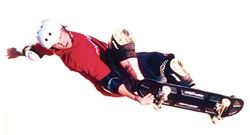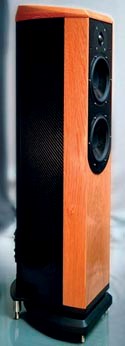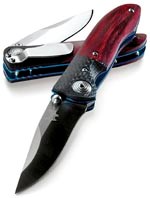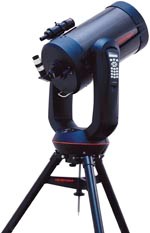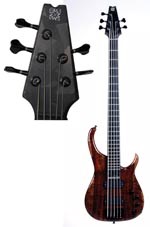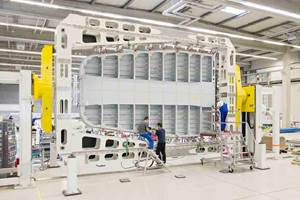Carbon fiber raises consumer performance index
Carbon bridges gap between large-volume sporting goods and aerospace to satisfy discriminating tastes in consumer and professional markets.
The development of composite materials opened the door for designers and engineers to create new shapes and achieve uncommon levels of performance. As a replacement for metals, composites have lightened aircraft and automobiles and improved the game of many a golfer and tennis player. Although glass fiber reinforcements got things rolling, it was the invention and application of carbon fiber in composites that provided the real opportunity to make significant advancements in these applications.
In the wake of such success, product manufacturers in other arenas have followed suit. Although not produced in the mass quantities typical of composite sporting goods, products positioned at the crossover point between consumer and professional quality in these markets now take advantage of carbon composites as substitutes not only for metal but wood as well, with remarkable results. In all cases where carbon has found a place, there runs a common theme: Carbon fiber improves performance, and in each market, there are plenty of people willing a pay a premium for that performance edge -- not to mention the carbon-inspired high-tech styling.
Music to the ears -- and more
Since the invention of the compact disc, the music industry has trumpeted the advantages of digital music. "Analog is history," the refrain went. In recent years, more and more audiophiles are rediscovering vinyl and tape, and the subtleties digital music can never duplicate. To appreciate these differences, higher quality equipment is required to play and broadcast it, and this is most significant in the choice of speakers.
Carbon fiber has found application in the cones of many high-performance speakers, either as a paper or light woven fabric. But Wilson Benesch Ltd. (Sheffield, U.K.) has taken carbon fiber to an entirely new level. Founded in 1989, the company's first products included a carbon-fiber turntable and a torsionally stiff carbon-fiber tonearm. Building on this technical success, Wilson Benesch introduced the first of its line of speakers in 1994, relying on carbon fiber's structural properties in the external housing of the speaker to provide improved damping and sound quality, giving buyers a purer listening experience. Distinguished by a curved two-piece cabinet featuring high-gloss, woven structural carbon fiber composite, the A.C.T. One (A.C.T. stands for Advanced Composite Technology) struck a note with music purists worldwide and was selected as the reference loudspeaker by a number of audio equipment reviewers. The A.C.T One was followed in 1997 by the slightly larger A.C.T. Two and several other speaker models, all incorporating carbon fiber in the structural cabinet. In 2002, Wilson Benesch developed an all-new speaker, named simply the A.C.T., to replace the One and the Two. The A.C.T. incorporates significant advancements in its construction.
Standing 1080 mm (42.5 inches) tall and weighing 78 kg (172 lb), the A.C.T relies on a lightweight composite and a heavy metallic structure to achieve the proper balance of strength and performance, explains Wilson Benesch director Andrew Scholey. Within the carbon composite housing, a rigid, welded steel backbone and hybrid steel/aluminum baffle rigidly support the speaker cones to minimize vibration. "The stiffness and damping characteristics of carbon fiber composite provides a low degree of 'colorization,' or the vibration typically seen with a wood-based speaker housing," Scholey emphasizes. The result is a cleaner replication of the musical performance.
While earlier speaker models relied on autoclaved sandwich structures of carbon fiber prepreg and Nomex honeycomb, the one-piece U-shaped monocoque housing for the A.C.T. is resin transfer molded, Scholey says, noting, "From our inception, we have produced the majority of our parts ourselves, and in so doing, have complete control over the quality." The A.C.T. housing is comprised of a 15-mm/0.59-inch-thick foam core encased by 2x2 twill woven fabric skins infused with epoxy resin. A skin thickness of 2.5 mm (0.100 inch) yields a sandwich structure with exceptional stiffness-to-weight characteristics.
The suggested retail price for a pair of A.C.T. speakers is $12,500 (USD), a relative bargain for speakers with these specifications. Scholey estimates the market for high-end speakers, which includes the A.C.T. and other Wilson Benesch models, is in the tens of thousands of units per year.
Lightweight tripods gain acceptance
A key element in obtaining a quality photograph is maintaining the stability of the camera. Trying to capture a long exposure simply through a steady hand is not sufficient -- some sort of stabilizing device, such as a tripod, is required. Backpackers, nature photographers and sports journalists rely on collapsible tripods to capture the action or the beauty of the outdoors. Frequent relocations and difficult to access locations make having the lightest gear not only handy, but essential. Durability is another factor in buying equipment, and carbon fiber composite tripods are both lightweight and durable.
Gitzo SA (Creteil, France) pioneered carbon fiber camera tripods in the mid-1990s, with Gruppo Manfrotto Srl (Bassano del Grappa, Italy) not far behind. Today, the two companies, which are both owned by Surrey, U.K.-based Vitec Group PLC, are the leading producers in this rapidly growing market. Both offer a wide range of carbon fiber tripods to satisfy various customers, ranging from performance-seeking amateurs to ultimate professionals. Retail prices range from around $250 to $800 (USD) depending on tripod size and features.
Justin Stailey, technical support engineer for Bogen Imaging Inc. (Ramsey, N.J.), explains that the market for carbon fiber tripods falls into several categories, including nature photographers, sports photographers, and local news video cameramen on the professional side, and affluent hobbyists, such as birdwatchers, on the consumer side. Bogen is the distribution arm of Vitec, supporting Gitzo and Manfrotto products in the U.S., France, Italy and Germany. Stailey says a typical carbon fiber tripod weighs 30 percent less than an all-aluminum equivalent, and newer models that combine carbon legs with magnesium (rather than aluminum) heads and fittings can weigh as much as 40 percent less. In a large tripod, this can mean a difference as great as 2.0 kg/4.4 lb, lightening the load or permitting the photographer to carry a longer lens or other equipment.
Although Gitzo and Manfrotto fall under the same management, their tripod products are differentiated by certain features, most significantly, the shape of the telescoping carbon-fiber legs. Gitzo legs are circular, and have a smooth, sanded appearance, while the Manfrotto legs have a textured surface and are formed in a trapezoidal, or "D" shape to resist twisting in the fittings. The Gitzo tubes have a 1.5 mm (0.060 inch) wall thickness, with upper leg diameters ranging from 22 mm to 41 mm (0.875 inch to 1.625 inch), depending on tripod size. Since Gitzo was the first producer of carbon tripods, the 1.5 mm wall was selected to fit existing aluminum hardware, which was sized for 1.5 mm aluminum tubing. By comparison, Manfrotto tubes have only a 1.2 mm (0.048 inch) wall thickness, and future Gitzo models are adopting the same thickness to further reduce weight, says Stailey.
Carbon fiber tubing for both product lines is produced by a process called pull winding, a hybrid pultrusion/filament winding technique in which longitudinal fibers are pulled over a round or trapezoidal mandrel that extends back to near the creel. As the fibers pass through the winding station, off-axis fibers are wound, with tension, around the zero-degree fibers, which compacts the dry bundle. The combined "continuous preform" enters a heated, tapered die (containing an inner mandrel and an outer mold that defines part thickness), where the resin is injected into the part in a continuous fashion under a fairly high pressure. As in conventional pultrusion, the part cures as it is pulled through the die, and tubes are cut to length by a flying saw.
Stailey estimates the current worldwide market for all makes of carbon fiber tripods at roughly 100,000 units annually, and growing strongly due to increasing sales of high-end, digital SLR cameras. In 2004, carbon fiber tripods constituted 60 percent of Gitzo's U.S. professional sales, and Stailey expects this figure to reach 75 percent in 2005 or 2006.
Striking the right chords
In the mid-1970s, an aerospace engineer named Geoff Gould was part of a team that produced the carbon-fiber dish antenna for the Voyager I space probe. Also a bass guitar player, Gould saw carbon fiber as a solution to problems common to the instruments he played, including dead spots and warping of the wood necks. The outcome of his experiments resulted in the introduction of the Quantum bass guitar in 1979, with a fully carbon fiber structural composite neck. Twenty-five years later, Modulus Guitars (Novato, Calif.) still sells the carbon fiber Quantum bass (albeit refined several times), as well as the more recently introduced lines of Genesis hybrid carbon/wood necked basses and electric guitars.
Modulus instruments are favored among professional musicians, from Phil Lesh of the legendary Grateful Dead to Stefan Lessard of the Dave Matthews Band and Flea of the Red Hot Chili Peppers. In addition to hundreds of professionals, Modulus has numerous fans among amateur guitarists as well. Prices for the instruments range from around $2,000 (USD) to slightly over $4,000.
The hollow neck of the Quantum bass is produced using three major components, explains Anderson Page, sales and marketing manager for Modulus. The curved rear shell is molded from hand layup carbon fiber prepreg and cured in an autoclave. The structural spine is a compression molded "T-section" with a flat top that forms the facing for the fingerboard. Both components are produced using Toray Composite America's (Tacoma, Wash.) fast-curing G83C prepreg reinforced with T600 carbon fiber. All molding is done in-house. The two components, along with the phenolic laminate fingerboard are bonded together with an epoxy paste adhesive supplied by Loctite Aerospace (Bay Point, Calif).
For the Genesis line of electric guitars and basses, hybrids of wood and carbon are employed to deliver a warmer tone. While the Quantum line is principally directed at rock and roll music, the Genesis instruments have found favor among musicians in jazz and country genres. "A small amount of carbon fiber composite, properly designed, can carry a lot of load," Page explains. In the Genesis lines, a compression molded T-stiffened carbon fiber "skeleton" runs the length of the neck, with the top of the "T" beneath the fingerboard, and is securely bolted into the body of the guitar. This single molded piece carries all string loads, permitting the use of softer woods, such as alder, cedar and soft maple, in the rear shell of the neck to add unique "signatures" to the sound.
Page admits the original Quantum bass has spawned a lot of imitators. "Anyone can laminate a sheet of carbon fiber on the neck and get some amount of benefit. But it doesn't make it a Modulus." A lot of musicians seem to agree.
A clearer view of the night sky
Since the dawn of man, there has been a great fascination with the stars, planets and other objects in the sky. The invention of the telescope has enhanced our understanding of the universe, and advanced in-space telescopes like Hubble and the Chandra X-Ray Observatory permit vision almost beyond human imagination.
For land-based humans, there are numerous telescopes on the market, replete with automated "go to" positioning systems based on Global Positioning System (GPS) technology and motorized mechanisms that enable the telescope to remain focused on a single point in the sky as the Earth rotates. One company that has incorporated carbon fiber into the construction of its high performance line of consumer telescopes is Celestron International (Torrance, Calif.). First introduced in 2001 on the NexStar 11 GPS (see HPC,May 2002, p. 64), carbon fiber optical tubes now are key components on five Celestron telescopes, in three diameters.
The carbon optical tube is a standard feature on the NexStar 8-inch, 9.25-inch and 11-inch models (203 mm, 235 mm and 280 mm, respectively; the sizes refer to the diameter of the aperture, with a larger size enabling the viewer to see farther and wider). Each is equipped with a computerized GPS mechanism. Recently, the company introduced the same tubes on its 8-inch and 11-inch CGE series, which use a German Equatorial mount instead of a fork arm for supporting the optical tube and telescope internals. All five models are Schmidt-Cassegrain telescopes, which use a series of lenses and mirrors to fold the optics and create a telescope that is quite compact compared to long, bulky refractor models.
Advantages of the carbon fiber tube include a 40 percent weight savings over aluminum, and a coefficient of thermal expansion (CTE) that is less than one-fourth that of the aluminum tube, according to Celestron's engineering manager Manishi Gupta. While its lower weight improves portability, the tube's low thermal expansion is important to users of lens-mounted cameras, especially those using charge coupled device (CCD) types, such as digital cameras. Another factor that cannot be overlooked is the high-tech image conveyed by the use of carbon, evident through the tube's glossy, woven surface.
Construction of the tube employs carbon fiber prepreg tapes and fabrics, plied at precise angles to obtain the needed stiffness and low CTE, notes Gupta, who confirms Celestron is currently buying from three tubing suppliers, each of which takes a slightly different approach to manufacturing. One fabricator is MacLean Quality Composites (West Jordan, Utah), where a core of unidirectional tape supplied by Newport Adhesives and Composites (Irvine, Calif.) is combined with a prepreg outer fabric from Advanced Composites Group (Tulsa, Okla.). A specially designed two-step cure ensures an excellent surface finish. Dimensional tolerances for roundness and parallelism of the ends are very tight.
List pricing on the CGE and NexStar products range from $2,000 to around $4,000, and Gupta points out "whenever the customer has a choice between the aluminum and carbon fiber optical tubes, they almost always choose carbon fiber."
Carbon again on the cutting edge
Some of the more unique consumer products taking advantage of carbon fiber to improve performance are custom knives. While anyone who has worked with freshly cured, thin sheets of carbon fiber composite can attest to how sharp the material is, in knives the blade remains in stainless steel and the carbon fiber replaces wood and metal in the handle.
Benchmade Knife Co. Inc. (Oregon City, Ore.) produces a wide range of custom, high-performance knives sold to backpackers, hunters, campers and law enforcement agencies, as well as to the military. The products are characterized by the use of high-strength materials and robust designs. Four of Benchmade's current designs use carbon fiber in the handles, says Joe Verbanac, marketing manager for Benchmade. These include the $140 fixed-blade 210 Activator, with a combination carbon/glass handle, the $190 folding-blade 690 with a handle of rosewood and carbon fiber, and the $210 folding-blade 770 Osborne with a full handle of woven carbon fiber composite. For knife collectors, Benchmade recently produced a limited run of the 960CFP Osborne, with full carbon handles and inlays of mother-of-pearl, retailing for $600.
And while the high tech look is a selling feature, the carbon fiber utility is much more than skin deep, says Verbanac. Each knife is designed to withstand high torsional forces and the use of carbon fiber composite ensures high damage tolerance. "For backpackers, every gram is important, and our carbon fiber knives are considerably lighter than those with metal handles," Verbanac explains. Case in point -- the 770 Osborne measures 165 mm (6.5 inches) long, yet weighs only 51 grams (1.8 oz). Benchmade purchases cured carbon fiber composite sheets produced from prepreg fabrics and machines each handle on a 5-axis mill prior to assembly.
As to the question of popularity, Verbanac is quite certain. "Every carbon fiber model we produce sells faster than we can make them."
Out the door and onto the half pipe
If you want to find where necessity meets invention, look no further than David Hadzicki, co-founder of Revolution Enterprises Inc. (Poway, Calif.) who, with his brother Joe, created the Revdeck carbon fiber skateboard. Five years ago, after experiencing the hassle of replacing numerous wood skateboard decks for his then 10 year-old son, Hadzicki knew there had to be a better way. Since 1989, Revolution has developed a number of high-performance products based on the properties of carbon fiber, including kayak paddles, sport kites and bicycle frames, so the extension of the product line to skateboards seemed logical. But the project proved to be the company's most daunting development effort to date.
"It took us four and a half years to get the design where it is today, and we're continuing to look for ways to improve the product," says David Hadzicki. "Getting the performance is easy with carbon fiber," he explains. The hard part was developing a product that was comfortable to ride and durable at the same time." Skateboard riders like the forgiveness that wood provides in a shock, but also want more spring, also known as "pop," when performing tricks that go by the colorful names of "ollies," "pop shovits," "grinds" and "kick flips." As with carbon fiber products from golf club shafts to airplane wings, the secret lies in tailoring the orientation and thickness of the carbon fiber in various areas of the 'board.
"Lots of people have tried to make a composite skateboard," Hadzicki explains, noting that most attempts have been wet lamination similar to surfboard manufacture. The result is a heavy board with poor "pop," providing no advantage to the rider. The Revdeck, by contrast, is compression molded in heated steel tools from a combination of unidirectional and woven carbon prepreg, supplied by Toray Composites America Inc (Tacoma, Wash.). Weighing only 930 grams (2.0 lb) in the 200-mm/8-inch-wide "Street" version, the foam cored sandwich is roughly 20 percent lighter than wood. The slightly wider and longer "Vert" model, used for aerial tricks in half pipe competitions, is only 55g (2 oz) heavier than the "Street" version.
Wooden boards have a number of drawbacks, according to Hadzicki. They are prone to performance degradation in wet weather, break easily and fatigue quickly. The polymer construction of the Revdeck eliminates weather effects, and the strength and stiffness of carbon reduces breakage and eliminates fatigue. "Someone who wants to break a Revdeck certainly can, but they'll have to try a lot harder than with wood," Hadzicki emphasizes. Riders should expect to ride the Revdeck four to ten times as long as a wood deck. As an example of endurance, Tas Pappas, who represents Revolution on the Professional Skate Tour, skated on one Revdeck for an entire two-month European tour before giving the 'board away (it is still in service). Pappas reportedly would have exhausted eight wood 'boards in the same timeframe.
Introduced in September 2004, the Revdeck is "flying" out the door, according to Hadzicki. Although a premium product with a retail price of $115, the opportunity is significant, with millions of wood skateboard decks sold annually.
The applications keep coming
Again and again, carbon fiber continues to prove its versatility in the replacement of more traditional materials. The material is showing up in laptop computer housings, briefcases and even furniture, as evidenced by the recent introduction of the Talon carbon fiber chair (see HPC September 2004, p. 47). Even American designer Ralph Lauren has entered the game, offering dining chairs and end tables featuring woven carbon fiber composites in the legs and supports. As the applications covered in this article attest, carbon adds functionality as well as good looks, a combination that's hard to beat.
Related Content
From the CW Archives: Airbus A400M cargo door
The inaugural CW From the Archives revisits Sara Black’s 2007 story on out-of-autoclave infusion used to fabricate the massive composite upper cargo door for the Airbus A400M military airlifter.
Read MorePlant tour: Albany Engineered Composites, Rochester, N.H., U.S.
Efficient, high-quality, well-controlled composites manufacturing at volume is the mantra for this 3D weaving specialist.
Read MoreGKN Aerospace, Joby Aviation sign aerostructures agreement
GKN Aerospace will manufacture thermoplastic composite flight control surfaces for Joby’s all-electric, four-passenger, composites-intensive ride-sharing aircraft.
Read MoreCompPair adds swift prepreg line to HealTech Standard product family
The HealTech Standard product family from CompPair has been expanded with the addition of CS02, a swift prepreg line.
Read MoreRead Next
“Structured air” TPS safeguards composite structures
Powered by an 85% air/15% pure polyimide aerogel, Blueshift’s novel material system protects structures during transient thermal events from -200°C to beyond 2400°C for rockets, battery boxes and more.
Read MoreVIDEO: High-volume processing for fiberglass components
Cannon Ergos, a company specializing in high-ton presses and equipment for composites fabrication and plastics processing, displayed automotive and industrial components at CAMX 2024.
Read MorePlant tour: Daher Shap’in TechCenter and composites production plant, Saint-Aignan-de-Grandlieu, France
Co-located R&D and production advance OOA thermosets, thermoplastics, welding, recycling and digital technologies for faster processing and certification of lighter, more sustainable composites.
Read More



